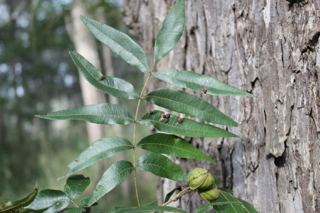Water Hickory
Carya aquatica
Family: Juglandaceae
Natural History

Leaf, fruit, and bark of aquatic hickory | Photo credit: Niels Proctor, University of Florida
As the common name would suggest, water hickory is a wetland tree, preferring to grow in places where the soil is close to saturated. In Florida it is often found in flood zones that only get submerged after major rainfall events. Large, slow-moving rivers like the Suwannee will often have a strip of bald cypress (Taxodium distichum) growing right in the shallows at the water's edge with a second strip of water hickory and sour gum (Nyssa spp.) growing slightly higher on the banks, above the normal water level.
Like all trees in the walnut family, water hickory has alternate, pinnately-compound leaves composed of narrow leaflets. To understand the family characteristics, compare it to black walnut (Juglans nigra), mockernut hickory (Carya tomentosa), pecan (Carya illinoinensis), and pignut hickory (Carya glabra). (Remember that ashes such as white ash are in the olive family and, while they also have pinnately-compound leaves, the leaf arrangement is opposite rather than alternate.)
Identification of water hickory is easiest in the field, where the habitat and the bark would provide strong clues. If you only have a branch sample, the leaf structure and arrangement should be enough to narrow it down to the right family. The number of leaflets (most commonly 9 to 11) should eliminate black walnut, pecan, and pignut hickory. Mockernut hickory can also have 9 leaflets, but the leaflets on that species are more rounded (not lanceolate) and they have a soft layer of hair on the underside that isn't seen in water hickory.
Water hickory isn't common enough to have any major commercial use. The wood tends to dull saw blades and it is difficult to mill into long sections of lumber. Shorter pieces are considered very impact- and shock-resistant, so they are used for things like spokes, ladder rungs, and axe handles that need to withstand repeated blows. The wood chips also make a good, slow-burning charcoal and are often used for cooking with grills and smokers.
